display LINCOLN MKS 2015 Workshop Manual
[x] Cancel search | Manufacturer: LINCOLN, Model Year: 2015, Model line: MKS, Model: LINCOLN MKS 2015Pages: 424, PDF Size: 3.96 MB
Page 153 of 424

PRINCIPLE OF OPERATION
The traction control system helps avoid drive
wheel spin and loss of traction.
If your vehicle begins to slide, the system
applies the brakes to individual wheels and,
when needed, reduces engine power at the
same time. If the wheels spin when
accelerating on slippery or loose surfaces,
the system reduces engine power in order to
increase traction.
USING TRACTION CONTROL
Note:
If your vehicle is equipped with MyKey®,
it is possible to prevent turning the traction
control system off. See MyKey ™ (page 50).
In certain situations for example, stuck in
snow or mud, turning the traction control off
may be beneficial as this allows the wheels
to spin with full engine power. Depending on
the type of system you have on your vehicle,
you can either turn the system off using the
information display or by pressing the button. Switching the System Off Using the
Information Display Controls
(If
Equipped)
Your vehicle comes with this feature already
enabled. If required, you can switch this
feature off using the information display
controls. See Principle of Operation (page
150
).
Switching the System Off Using a
Switch
(If Equipped)
The button is located in the instrument panel.
Press the button. You will see a message in
conjunction with an illuminated icon in the
display. Press the button again to return the
system to normal mode.
When you switch the traction control system
off, stability control remains fully active. System Indicator Lights and
Messages WARNING
If a failure has been detected within the
AdvanceTrac system, the stability
control light will illuminate steadily.
Verify that the AdvanceTrac system was not
manually disabled through the information
display. If the stability control light still
illuminates steadily, have the system serviced
by an authorized dealer immediately.
Operating your vehicle with AdvanceTrac
disabled could lead to an increased risk of
loss of vehicle control, vehicle rollover,
personal injury and death. The stability control light
temporarily illuminates on engine
start-up and flashes when a driving
condition activates the stability system. The stability control off light
temporarily illuminates on engine
start-up and stays on when you
turn the traction control system off.
When you turn the traction control system
off or on, a message appears in the
information display showing system status.
150
MKS (), enUSA Traction ControlE138639
Page 156 of 424

PARKING AID (If Equipped)
WARNINGS
To help avoid personal injury, please
read and understand the limitations of
the system as contained in this section.
Sensing is only an aid for some (generally
large and fixed) objects when moving on a
flat surface at parking speeds. Certain objects
with surfaces that absorb ultrasonic waves,
traffic control systems, fluorescent lamps,
inclement weather, air brakes, and external
motors and fans may also affect the function
of the sensing system; this may include
reduced performance or a false activation. To help avoid personal injury, always
use caution when in reverse (R) and
when using the sensing system.
This system is not designed to prevent
contact with small or moving objects.
The system is designed to provide a
warning to assist the driver in detecting large
stationary objects to avoid damaging the
vehicle. The system may not detect smaller
objects, particularly those close to the
ground. WARNINGS
Certain add-on devices such as large
trailer hitches, bike or surfboard racks
and any device that may block the
normal detection zone of the system, may
create false beeps. Note:
Keep the sensors, located on the
bumper or fascia, free from snow, ice and large
accumulations of dirt. If the sensors are
covered, the system ’s accuracy can be
affected. Do not clean the sensors with sharp
objects.
Note: If your vehicle sustains damage to the
bumper or fascia, leaving it misaligned or bent,
the sensing zone may be altered causing
inaccurate measurement of obstacles or false
alarms.
Note: If your vehicle is equipped with
MyKey ™, it is possible to prevent turning the
sensing system off. See
MyKey ™ (page 50).
The sensing system warns the driver of
obstacles within a certain range of the
bumper area. The system turns on
automatically whenever you switch the
ignition on. When receiving a detection warning, the radio
volume reduces to a predetermined level.
After the warning goes away, the radio
volume returns to the previous level.
You can switch the system off through the
information display menu or from the pop-up
message that appears once you shift the
transmission into reverse (R). If your vehicle
is equipped with a front sensing system, you
can switch the system off using the parking
aid switch. See General Information (page
88
).
If a fault is present in the system, a warning
message appears in the information display
and you cannot switch the system on through
the pop-up message or parking aid switch.
See
Information Messages (page 94).
Rear Sensing System
The rear sensors are only active when the
transmission is in reverse (R). As the vehicle
moves closer to the obstacle, the rate of the
audible warning increases. When the
obstacle is less than
12 in (30 cm) away, the
warning sounds continuously. If the system
detects a stationary or receding object farther
than
12 in (30 cm) from the side of the
vehicle, the tone sounds for only three
seconds. Once the system detects an object
approaching, the warning sounds again.
153
MKS (), enUSA Parking Aids
Page 157 of 424
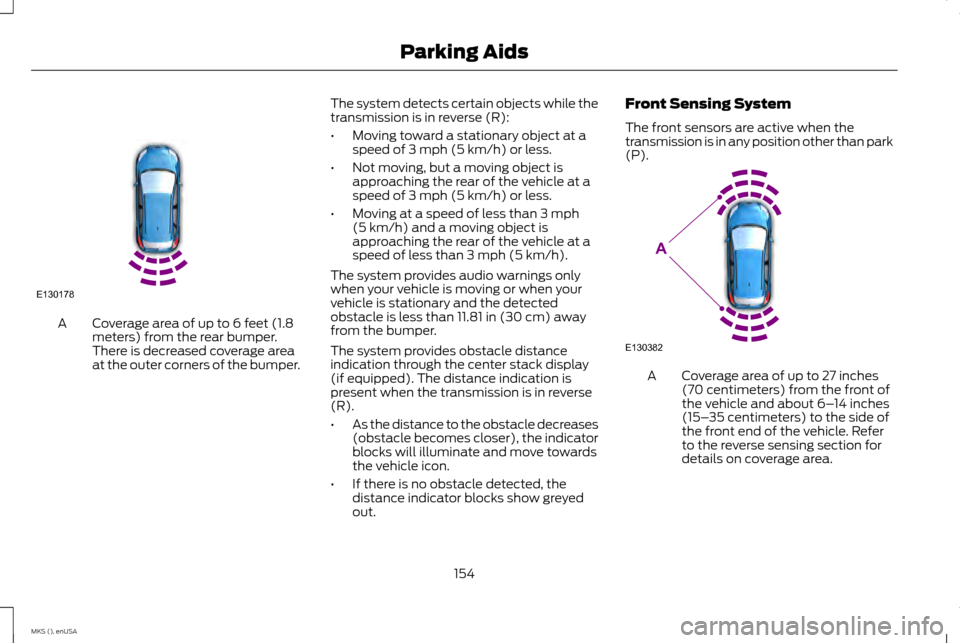
Coverage area of up to 6 feet (1.8
meters) from the rear bumper.
There is decreased coverage area
at the outer corners of the bumper.
A The system detects certain objects while the
transmission is in reverse (R):
•
Moving toward a stationary object at a
speed of 3 mph (5 km/h) or less.
• Not moving, but a moving object is
approaching the rear of the vehicle at a
speed of
3 mph (5 km/h) or less.
• Moving at a speed of less than
3 mph
(5 km/h) and a moving object is
approaching the rear of the vehicle at a
speed of less than
3 mph (5 km/h).
The system provides audio warnings only
when your vehicle is moving or when your
vehicle is stationary and the detected
obstacle is less than
11.81 in (30 cm) away
from the bumper.
The system provides obstacle distance
indication through the center stack display
(if equipped). The distance indication is
present when the transmission is in reverse
(R).
• As the distance to the obstacle decreases
(obstacle becomes closer), the indicator
blocks will illuminate and move towards
the vehicle icon.
• If there is no obstacle detected, the
distance indicator blocks show greyed
out. Front Sensing System
The front sensors are active when the
transmission is in any position other than park
(P).
Coverage area of up to 27 inches
(70 centimeters) from the front of
the vehicle and about 6–
14 inches
(15– 35 centimeters) to the side of
the front end of the vehicle. Refer
to the reverse sensing section for
details on coverage area.
A
154
MKS (), enUSA Parking AidsE130178 E130382
A
Page 158 of 424
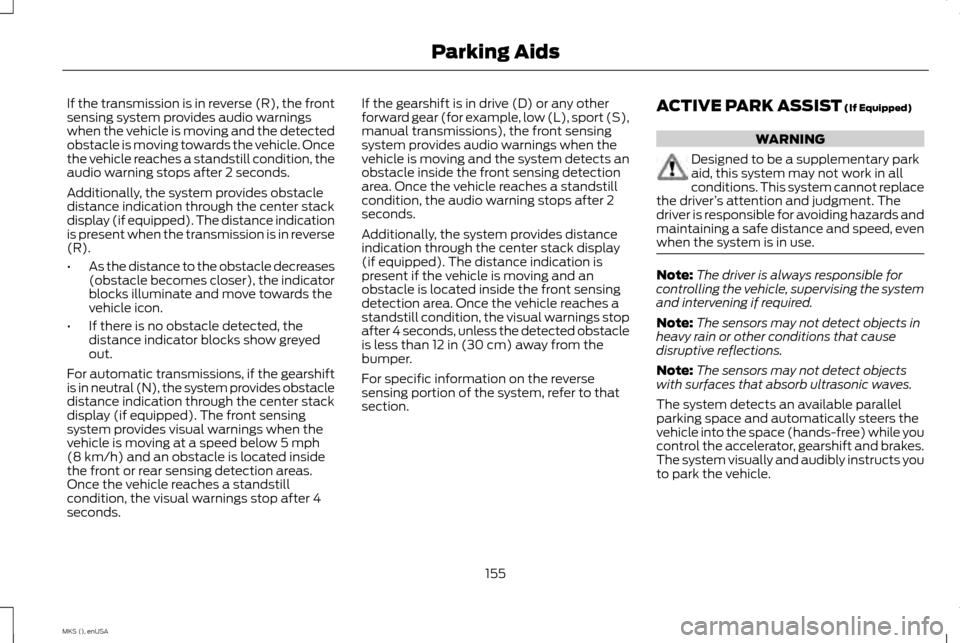
If the transmission is in reverse (R), the front
sensing system provides audio warnings
when the vehicle is moving and the detected
obstacle is moving towards the vehicle. Once
the vehicle reaches a standstill condition, the
audio warning stops after 2 seconds.
Additionally, the system provides obstacle
distance indication through the center stack
display (if equipped). The distance indication
is present when the transmission is in reverse
(R).
•
As the distance to the obstacle decreases
(obstacle becomes closer), the indicator
blocks illuminate and move towards the
vehicle icon.
• If there is no obstacle detected, the
distance indicator blocks show greyed
out.
For automatic transmissions, if the gearshift
is in neutral (N), the system provides obstacle
distance indication through the center stack
display (if equipped). The front sensing
system provides visual warnings when the
vehicle is moving at a speed below 5 mph
(8 km/h) and an obstacle is located inside
the front or rear sensing detection areas.
Once the vehicle reaches a standstill
condition, the visual warnings stop after 4
seconds. If the gearshift is in drive (D) or any other
forward gear (for example, low (L), sport (S),
manual transmissions), the front sensing
system provides audio warnings when the
vehicle is moving and the system detects an
obstacle inside the front sensing detection
area. Once the vehicle reaches a standstill
condition, the audio warning stops after 2
seconds.
Additionally, the system provides distance
indication through the center stack display
(if equipped). The distance indication is
present if the vehicle is moving and an
obstacle is located inside the front sensing
detection area. Once the vehicle reaches a
standstill condition, the visual warnings stop
after 4 seconds, unless the detected obstacle
is less than
12 in (30 cm) away from the
bumper.
For specific information on the reverse
sensing portion of the system, refer to that
section. ACTIVE PARK ASSIST
(If Equipped) WARNING
Designed to be a supplementary park
aid, this system may not work in all
conditions. This system cannot replace
the driver ’s attention and judgment. The
driver is responsible for avoiding hazards and
maintaining a safe distance and speed, even
when the system is in use. Note:
The driver is always responsible for
controlling the vehicle, supervising the system
and intervening if required.
Note: The sensors may not detect objects in
heavy rain or other conditions that cause
disruptive reflections.
Note: The sensors may not detect objects
with surfaces that absorb ultrasonic waves.
The system detects an available parallel
parking space and automatically steers the
vehicle into the space (hands-free) while you
control the accelerator, gearshift and brakes.
The system visually and audibly instructs you
to park the vehicle.
155
MKS (), enUSA Parking Aids
Page 159 of 424

The system may not function correctly if
something passes between the front bumper
and the parking space (a pedestrian or
cyclist) or if the edge of the neighboring
parked vehicle is high off the ground (for
example, a bus, tow truck or flatbed truck).
Do not use the system if:
•
You have attached a foreign object (bike
rack or trailer) to the front or rear of your
vehicle or attached close to the sensors.
• You have attached an overhanging object
(surfboard) to the roof. •
The front bumper or side sensors are
damaged or obstructed by a foreign
object (front bumper cover).
• A mini-spare tire is in use.
Using Active Park Assist Press the button located on the
right side of the center stack.
The touchscreen displays a message and a
corresponding graphic to indicate it is
searching for a parking space. Use the
direction indicator to indicate which side of
your vehicle you want the system to search.
Note:
If the direction indicator is not on, the
system automatically searches on the vehicle's
passenger side. 156
MKS (), enUSA Parking AidsE144525 A
E130107
Page 160 of 424

When the system finds a suitable space, the
touchscreen displays a message and a chime
sounds. Slow down, continue moving forward
and stop when another chime sounds and a
message displays on the touchscreen (at
approximately position A), then follow the
instructions on the touchscreen.
Note:
You must observe that the selected
space remains clear of obstructions at all
times in the maneuver.
Note: Active park assist may not detect
vehicles with overhanging loads (a bus or a
truck), street furniture and other items. You
must make sure the selected space is suitable
for parking. Note:
You should drive your vehicle as parallel
to the other vehicles as possible while passing
a parking space.
Note: The system always offers the last
detected parking space (for example, if the
vehicle detects multiple spaces while you are
driving, it offers the last one).
Note: If driven above approximately 20 mph
(35 km/h), the touch screen shows a message
to alert you to reduce your vehicle speed. Automatic Steering into Parking
Space
Note:
If vehicle speed exceeds 6 mph (10
km/h), the system switches off and you need
to take full control of your vehicle.
When you shift the transmission into Reverse
(R), with your hands off the wheel (and
nothing obstructing its movement), your
vehicle steers itself into the space. Indicated
by tones, instructions to move your vehicle
back and forth in the space, display on the
touchscreen. 157
MKS (), enUSA Parking AidsE130108
Page 161 of 424
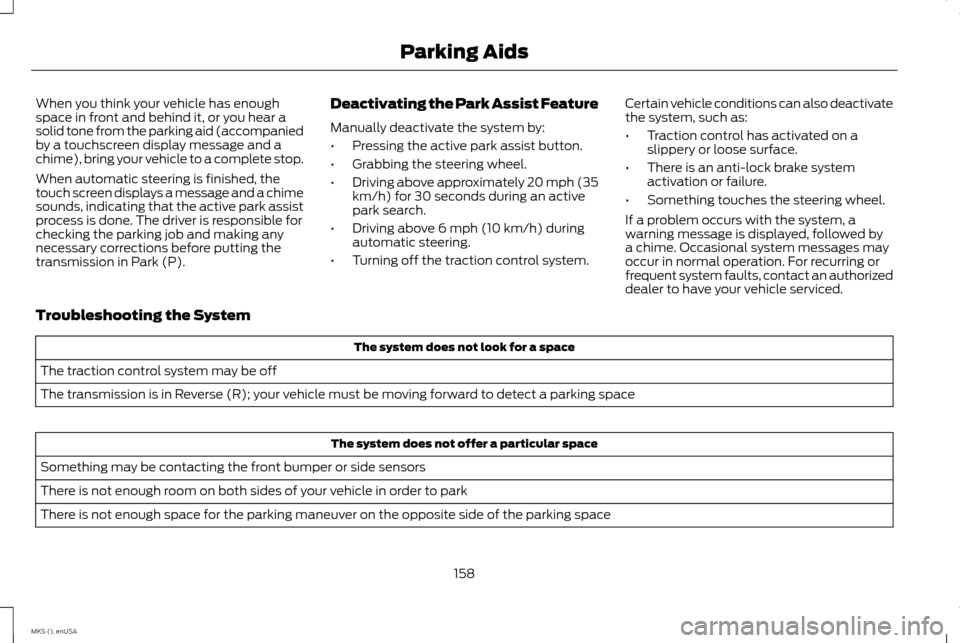
When you think your vehicle has enough
space in front and behind it, or you hear a
solid tone from the parking aid (accompanied
by a touchscreen display message and a
chime), bring your vehicle to a complete stop.
When automatic steering is finished, the
touch screen displays a message and a chime
sounds, indicating that the active park assist
process is done. The driver is responsible for
checking the parking job and making any
necessary corrections before putting the
transmission in Park (P).
Deactivating the Park Assist Feature
Manually deactivate the system by:
•
Pressing the active park assist button.
• Grabbing the steering wheel.
• Driving above approximately 20 mph (35
km/h) for 30 seconds during an active
park search.
• Driving above 6 mph (10 km/h) during
automatic steering.
• Turning off the traction control system. Certain vehicle conditions can also deactivate
the system, such as:
•
Traction control has activated on a
slippery or loose surface.
• There is an anti-lock brake system
activation or failure.
• Something touches the steering wheel.
If a problem occurs with the system, a
warning message is displayed, followed by
a chime. Occasional system messages may
occur in normal operation. For recurring or
frequent system faults, contact an authorized
dealer to have your vehicle serviced.
Troubleshooting the System The system does not look for a space
The traction control system may be off
The transmission is in Reverse (R); your vehicle must be moving forward to detect a parking space The system does not offer a particular space
Something may be contacting the front bumper or side sensors
There is not enough room on both sides of your vehicle in order to park
There is not enough space for the parking maneuver on the opposite side of the parking space
158
MKS (), enUSA Parking Aids
Page 163 of 424
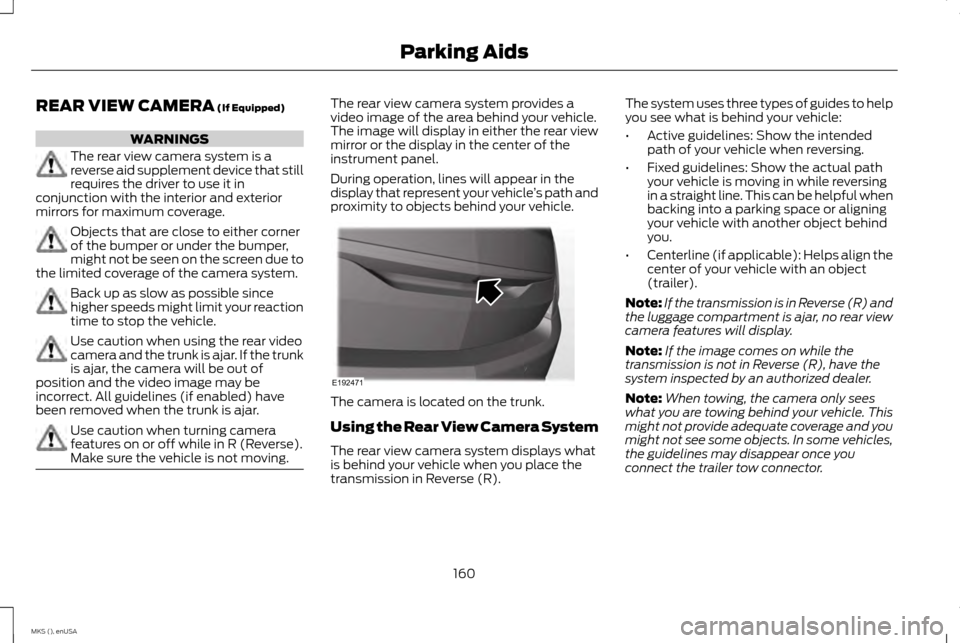
REAR VIEW CAMERA (If Equipped)
WARNINGS
The rear view camera system is a
reverse aid supplement device that still
requires the driver to use it in
conjunction with the interior and exterior
mirrors for maximum coverage. Objects that are close to either corner
of the bumper or under the bumper,
might not be seen on the screen due to
the limited coverage of the camera system. Back up as slow as possible since
higher speeds might limit your reaction
time to stop the vehicle.
Use caution when using the rear video
camera and the trunk is ajar. If the trunk
is ajar, the camera will be out of
position and the video image may be
incorrect. All guidelines (if enabled) have
been removed when the trunk is ajar. Use caution when turning camera
features on or off while in R (Reverse).
Make sure the vehicle is not moving. The rear view camera system provides a
video image of the area behind your vehicle.
The image will display in either the rear view
mirror or the display in the center of the
instrument panel.
During operation, lines will appear in the
display that represent your vehicle
’s path and
proximity to objects behind your vehicle. The camera is located on the trunk.
Using the Rear View Camera System
The rear view camera system displays what
is behind your vehicle when you place the
transmission in Reverse (R).The system uses three types of guides to help
you see what is behind your vehicle:
•
Active guidelines: Show the intended
path of your vehicle when reversing.
• Fixed guidelines: Show the actual path
your vehicle is moving in while reversing
in a straight line. This can be helpful when
backing into a parking space or aligning
your vehicle with another object behind
you.
• Centerline (if applicable): Helps align the
center of your vehicle with an object
(trailer).
Note: If the transmission is in Reverse (R) and
the luggage compartment is ajar, no rear view
camera features will display.
Note: If the image comes on while the
transmission is not in Reverse (R), have the
system inspected by an authorized dealer.
Note: When towing, the camera only sees
what you are towing behind your vehicle. This
might not provide adequate coverage and you
might not see some objects. In some vehicles,
the guidelines may disappear once you
connect the trailer tow connector.
160
MKS (), enUSA Parking AidsE192471
Page 165 of 424
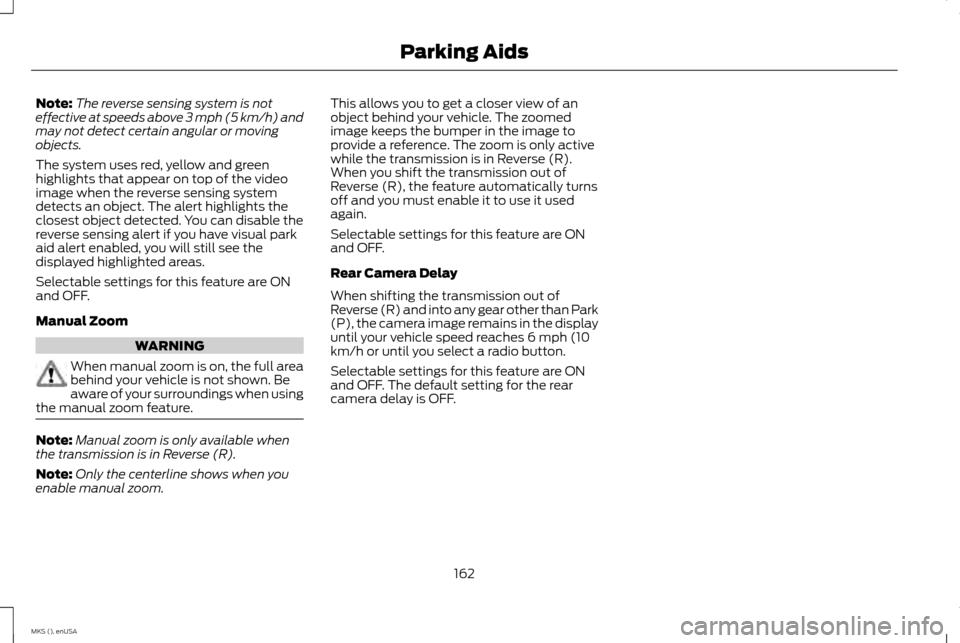
Note:
The reverse sensing system is not
effective at speeds above 3 mph (5 km/h) and
may not detect certain angular or moving
objects.
The system uses red, yellow and green
highlights that appear on top of the video
image when the reverse sensing system
detects an object. The alert highlights the
closest object detected. You can disable the
reverse sensing alert if you have visual park
aid alert enabled, you will still see the
displayed highlighted areas.
Selectable settings for this feature are ON
and OFF.
Manual Zoom WARNING
When manual zoom is on, the full area
behind your vehicle is not shown. Be
aware of your surroundings when using
the manual zoom feature. Note:
Manual zoom is only available when
the transmission is in Reverse (R).
Note: Only the centerline shows when you
enable manual zoom. This allows you to get a closer view of an
object behind your vehicle. The zoomed
image keeps the bumper in the image to
provide a reference. The zoom is only active
while the transmission is in Reverse (R).
When you shift the transmission out of
Reverse (R), the feature automatically turns
off and you must enable it to use it used
again.
Selectable settings for this feature are ON
and OFF.
Rear Camera Delay
When shifting the transmission out of
Reverse (R) and into any gear other than Park
(P), the camera image remains in the display
until your vehicle speed reaches 6 mph (10
km/h or until you select a radio button.
Selectable settings for this feature are ON
and OFF. The default setting for the rear
camera delay is OFF.
162
MKS (), enUSA Parking Aids
Page 167 of 424
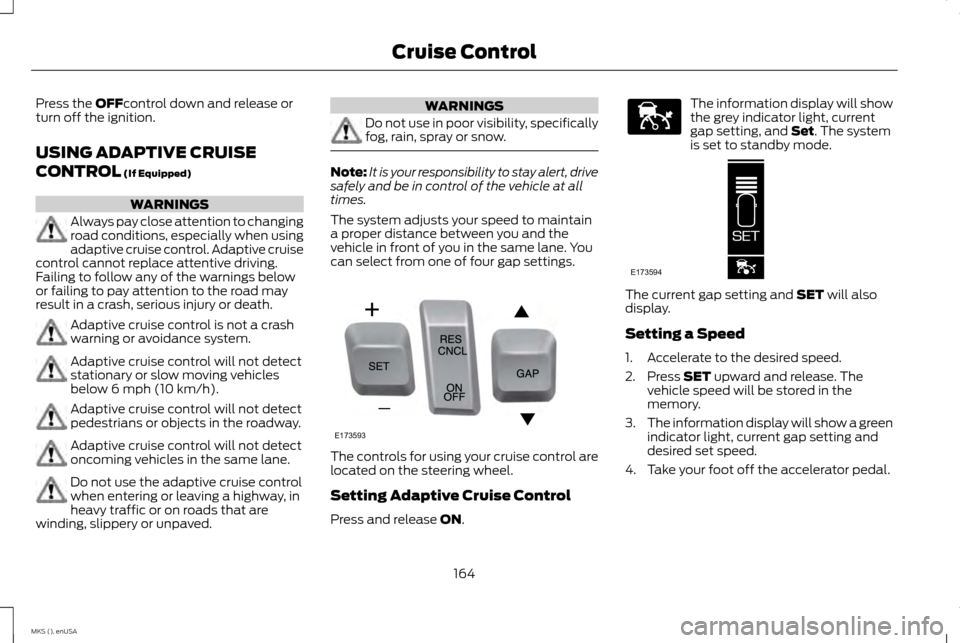
Press the OFFcontrol down and release or
turn off the ignition.
USING ADAPTIVE CRUISE
CONTROL
(If Equipped) WARNINGS
Always pay close attention to changing
road conditions, especially when using
adaptive cruise control. Adaptive cruise
control cannot replace attentive driving.
Failing to follow any of the warnings below
or failing to pay attention to the road may
result in a crash, serious injury or death. Adaptive cruise control is not a crash
warning or avoidance system.
Adaptive cruise control will not detect
stationary or slow moving vehicles
below 6 mph (10 km/h).
Adaptive cruise control will not detect
pedestrians or objects in the roadway.
Adaptive cruise control will not detect
oncoming vehicles in the same lane.
Do not use the adaptive cruise control
when entering or leaving a highway, in
heavy traffic or on roads that are
winding, slippery or unpaved. WARNINGS
Do not use in poor visibility, specifically
fog, rain, spray or snow.
Note:
It is your responsibility to stay alert, drive
safely and be in control of the vehicle at all
times.
The system adjusts your speed to maintain
a proper distance between you and the
vehicle in front of you in the same lane. You
can select from one of four gap settings. The controls for using your cruise control are
located on the steering wheel.
Setting Adaptive Cruise Control
Press and release
ON. The information display will show
the grey indicator light, current
gap setting, and
Set. The system
is set to standby mode. The current gap setting and
SET will also
display.
Setting a Speed
1. Accelerate to the desired speed.
2. Press
SET upward and release. The
vehicle speed will be stored in the
memory.
3. The information display will show a green
indicator light, current gap setting and
desired set speed.
4. Take your foot off the accelerator pedal.
164
MKS (), enUSA Cruise ControlE173593 E144529 E173594